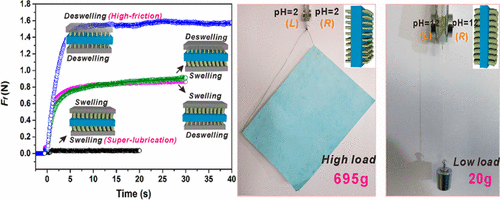Synthetic two-sided gecko's foot could enable underwater robotics

Geckos are well known for effortlessly scrambling up walls and upside down across ceilings. Even in slippery rain forests, the lizards maintain their grip. Now scientists have created a double-sided adhesive that copies this reversible ability to stick and unstick to surfaces even in wet conditions. They say their development, reported in ACS' Journal of Physical Chemistry C, could be useful in underwater robotics, sensors and other bionic devices.
Inspired by geckos' natural ability to attach and release their feet from surfaces as slick as glass, scientists have made a number of adhesives that can similarly stick and unstick with changes in temperature, light or magnetic field, but mostly in dry conditions. One promising approach to expanding this to underwater scenarios involves hydrogels that can swell and shrink in response to different acidity levels and other conditions. These volume differences change the gels' friction and stickiness levels.
Feng Zhou, Daniele Dini and colleagues recently developed a method to integrate nanostructured hydrogel fibers on an inorganic membrane. The material's friction and stickiness levels changed with pH even when wet. The researchers wanted to further expand on this strategy to make the adhesive work on two sides.
The researchers first made the inorganic membrane double-faced and then added the hydrogel nanofibers on both sides. Testing showed that the material exhibited ultra-high friction and adhesion in an acidic liquid (pH of 2), and would rapidly switch to a state of ultra-low friction and stickiness when a basic solution (pH of 12) was added. Additionally, the two sides of the material can stick and slide independently of each other.
More information: Shuanhong Ma et al. Nanohydrogel Brushes for Switchable Underwater Adhesion, The Journal of Physical Chemistry C (2017). DOI: 10.1021/acs.jpcc.7b01305
Abstract
In nature, living systems commonly adopt the switchable friction/adhesion mechanism during locomotion. For example, geckos can move on ceilings, relying on the reversible attachment and detachment of their feet on substrate surfaces. Inspired by this scientists have used different materials to mimic natural dynamic friction/adhesion systems. However, synthetic systems usually cannot work in water environments and are also limited to single-contact interfaces, while nature has provided living systems with complex features to perform energy dissipation and adhere on multiple contact interfaces. Here, for the first time, we report the design, synthesis, and testing of a novel double-sided synthetic construct that relies on nanohydrogel brushes to provide simultaneous friction switching on each side of the membrane that separates the nanohydrogel fibers. This highly tunable response is linked to the swelling and shrinkage of the brushes in basic/acid media. Such a system shows three different friction states, which depend on the combination of pH control of the two membrane sides. Importantly, each side of the membrane can independently provide continuous but stable friction switching from high to ultralow friction coefficients in a wet environment under high load conditions. An in-depth theoretical study is performed to explore the mechanisms governing the hydration state responsible for the observed switching. This novel design opens a promising route for the development of new solutions for intelligent devices, which can adapt to multistimulus-responsive complex environments.
Journal information: Journal of Physical Chemistry C
Provided by American Chemical Society





















